Exploring The Different Styles of Wood Carving

Welcome to the fascinating world of wood carving! We’re going to be taking a look at and exploring the different styles of wood carving. As an avid woodworking enthusiast, I have had the pleasure of exploring this art form for many years and have gained a wealth of knowledge and experience along the way. I am excited to share my insights with you and help guide you on your journey as a wood carver.
We’ll talk about choosing the right tools for the job and about some of the different carving techniques you might like to turn your hand too, and I’ll also share some of my personal experiences along the way.
So whether you are just starting out and looking for guidance or are an experienced woodworker seeking new challenges, there is something for everyone in the world of wood carving.
Let’s dive in and explore the joys and rewards of this wonderful craft together!
Getting Started with Wood Carving
When I first became interested in wood carving, I didn’t know where to start, I had no idea what tools a beginner wood carver needs but I was lucky enough to have a friend who was a skilled woodworker, and he was able to show me the ropes. If you don’t have someone like that to guide you, don’t worry – there are plenty of resources available to help you get started.
One of the best ways to start learning about wood carving is by taking on small projects. Don’t try to bite off more than you can chew – start with something simple and work your way up from there. To start with, you could try carving a small figurine or a simple spoon. Not only will this help you get a feel for the tools and techniques involved, it will also give you a sense of accomplishment as you complete each project.
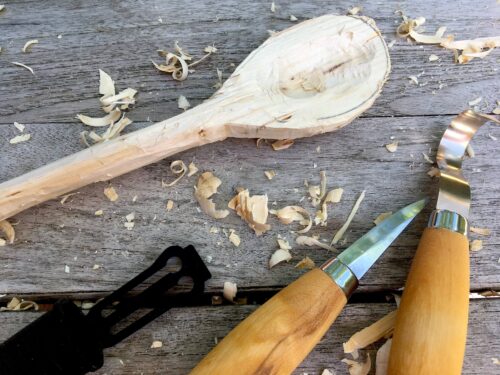
As you gain more experience and confidence, you can start taking on more complex projects, like sculptural carving so don’t be afraid to take risks and try new things – that’s how you’ll grow as a woodworker.
The Joys of Wood Carving
One of the things I love most about wood carving is the sense of satisfaction it brings. There’s something truly magical about taking a piece of wood and turning it into something beautiful and useful. Whether you’re creating a functional item like a spoon or a decorative piece like a figurine, the sense of accomplishment you feel when you complete a project is unlike anything else.
But wood carving is about more than just the finished product – it’s also about the process. The act of carving itself is incredibly soothing and meditative. It allows you to clear your mind and focus on the task at hand, which can be incredibly therapeutic.
Different Types of Woodworking
Wood carving is just one aspect of the larger world of woodworking. Other popular techniques include woodturning, where you use a woodturning lathe to shape and smooth pieces of wood, and furniture making, where you create pieces of furniture from scratch.
No matter which type of woodworking you’re interested in, there are lots of resources available to help you get started, from online tutorials and instructional videos to local classes and workshops, there’s no shortage of ways to learn the skills you need to succeed.
Tools and Materials
One of the great things about woodworking is that you don’t need a ton of fancy wood carving tools to get started. Although you’ll definitely want to invest in some high-quality woodworking tools as you gain more experience, you can get started with just a few basic tools.
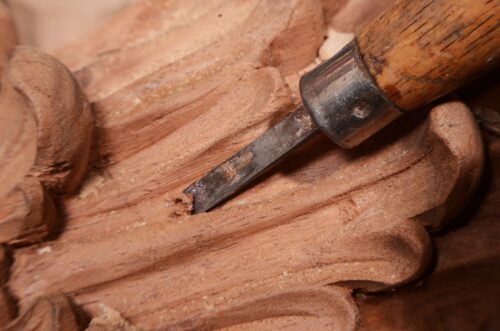
For wood carving, you’ll need a few essential tools, such as a wood carving knife, chisels, and a mallet, a woodworking bench really does help too. You’ll also want to have a selection of different grits of sandpaper on hand, as well as some wood finish to protect your finished pieces.
As far as materials go, you’ll want to choose a type of wood that is easy to work with. Some good options for beginners include basswood, pine, and balsa wood. These types of wood are relatively soft and easy to carve, which makes them a great choice for those just starting out.
Gaining Skills and Moving On to More Advanced Projects
As you progress in your wood carving journey, you will naturally improve your skills and be able to take on more complex projects. This can be a thrilling time, as you’ll be able to showcase your growing expertise through increasingly intricate and impressive pieces.
With practice and dedication, you’ll be amazed at what you can create and the sense of pride you’ll feel with each finished project. Keep pushing yourself to learn new techniques and take on new challenges – the sky is the limit in the world of wood carving!
As you gain more and more experience, you might also consider branching out into other types of woodworking, such as woodturning or furniture making. Each type of woodworking requires its own set of skills and techniques, so it’s a great way to continue learning and growing as a woodworker.
Wood Carving Techniques
There are many different techniques that can be used in woodworking, and the specific technique you choose will depend on the project you’re working on and your personal preference. Experimenting with different techniques will help you discover your own voice and style as a wood carver, and allow you to eventually create truly original and beautiful works of art.
Relief Carving
Relief carving is a type of sculpture in which the design is carved into a flat surface, creating a raised image that stands out from the surrounding background. This technique is often used to create ornamental panels, plaques, and figurines.
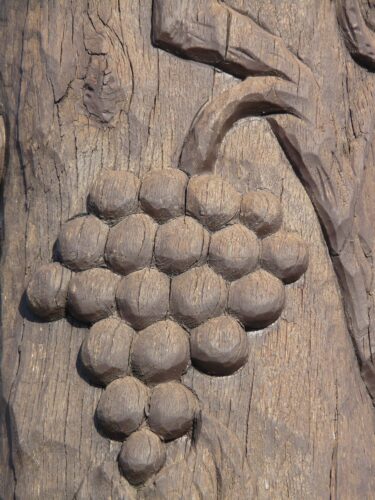
You start off by sketching your design onto the surface of the material, then use a variety of hand tools, such as chisels and gouges, to carefully remove material from the surface, following the lines of the design. As you carve, you may also use a hammer and a mallet to shape the material and add detail to the design.
Relief carving can be a challenging but a rewarding art form, as it requires a high level of precision and attention to detail. However, with practice and patience, anyone can learn the basic techniques of relief carving and create beautiful, unique and intricate works of art.
Chip Carving
Chip carving, also known as kerf carving, is a type of relief carving in which small, triangular chips of wood are removed from the surface of the material to create a decorative pattern. It’s often used to add intricate details and designs to wooden objects, such as boxes, frames, and decorative plaques.
To create a chip carving, you first must begin by sketching the desired design onto the surface of the wood. Then using a sharp knife, such as a chip carving knife or a V-tool, carefully cut small, triangular chips out of the wood along the lines of the design. The chips can be removed in a variety of patterns and arrangements, such as straight lines, zigzags, and geometric shapes.
Chip carving is a relatively quick and easy technique to learn, making it a popular choice for beginners and experienced woodcarvers alike.
Whittling
Whittling or carving with a knife is a traditional form of carving in which a single knife is used to remove small shavings of wood from a piece of material to create a desired shape or form. This technique is often associated with rustic, folk-art style carvings and can be used to create a wide range of projects, from small figurines and toys to larger sculptural pieces.

To whittle, begin by selecting a piece of wood, if you are a beginner then it’s best to select wood that is soft and easy to carve, such as basswood or pine. Use a sharp knife, such as a pocket knife or a carving knife, to carefully cut away small shavings of wood from the surface of the material. As you work, use different techniques, such as slicing, chopping, and paring, to shape the wood to create the desired form.
Whittling is a simple and enjoyable pastime that can be enjoyed by people of all ages and skill levels. It requires minimal equipment such as a pocket knife and can be done almost anywhere, making it a popular choice for both professional and amateur carvers. Give it a try!
Carving With Chisels
I can tell you that chisels are one of the most essential tools in any woodcarver’s toolkit, they come in a variety of sizes and shapes, and each one is designed for a specific purpose. For example, you might use a narrow, pointed chisel for fine, detailed work, or a wider chisel with a flat blade for roughing out larger areas of wood.
One of the great things about chisels is that they are very versatile tools, you can use them to remove wood in precise cuts, create smooth, flat surfaces, or add texture and detail to your carvings. They are also relatively easy to use, especially if you take the time to keep them maintained by sharpening the blade regularly.
With so many sizes and shapes to choose from, you’ll want to pick the one that best fits your needs. Once you have your chisel in hand, it’s time to start carving! Begin by making rough cuts to shape the wood and remove large chunks. As you work, you use various chiseling techniques, such as slicing, paring, and scraping, to refine your cuts and add intricate detail.
Carving With Gouges
Gouges are a type of carving tool with a curved blade that are used to remove larger amounts of wood from a piece. They are available in a range of sizes and shapes, and are commonly used to create curves and hollows in wood carving.
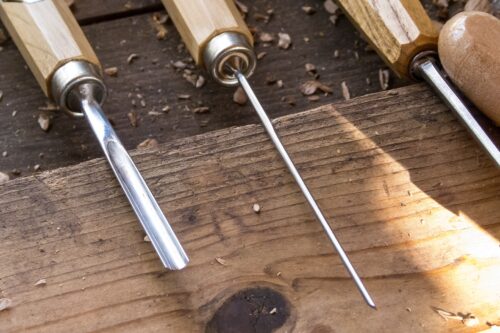
Gouges are a versatile tool that can be used to create a wide range of effects, such as shallow curves and hollows, deep grooves, and sweeping lines. They are also great for roughing out large areas of wood and adding texture to your carvings.
To use a gouge in wood carving, you can begin by making rough cuts to shape the wood and remove large chunks. As you work, you use different gouging techniques, such as slicing and scooping, to refine your cuts and add detail.
Carving With Power Tools
As a wood carver I have found power carvers to be a game-changer. They save such a lot of time and effort, and allow me to tackle larger and more complex projects with ease.
One of my go-to tools for wood carving is my power carving tool because it’s incredibly versatile and can be used for a variety of tasks, such as carving, engraving, and sanding. It’s especially useful for quickly removing large amounts of wood or for creating precise, detailed cuts. I’ve used it to carve everything from small figurines to large sculptural pieces, and it has always performed admirably.
These tools are essentially an electric version of a hand chisel, I often use them to carve out large, sweeping curves and to add intricate details to my projects.
Carving With Pyrography
Pyrography, also known as wood burning, is the art of creating designs on wood by burning the surface of the material with a heated tool. This technique has been around for centuries and is a popular way to decorate and personalize wooden objects, such as boxes, frames, and plaques.
To create a pyrography design, begin by sketching the desired image onto the surface of the wood, then use a pyrography pen, which is a tool with a heated tip, to burn and carve the lines of the design into the wood. You can control the heat of the pen and the pressure applied to the wood to create different effects, such as light and dark shading and textured lines.
Pyrography is a fun and rewarding carving art form that enables you to create a wide range of designs and effects on wood. It is a relatively simple technique to learn, and with practice, you can create beautiful, intricate designs with a minimum of equipment.
If you’re interested in the creative art of wood burning, it is well worth the investment to purchase a good pyrography pen and of course some wood to practice on.
Axe Carving
Incase you haven’t heard of axe carving, it’s a technique used to create intricate designs and patterns on wood using, yes you guessed it… an axe. It is a traditional method of woodworking that has been around for centuries and is still practiced today by skilled craftsmen and artisans.
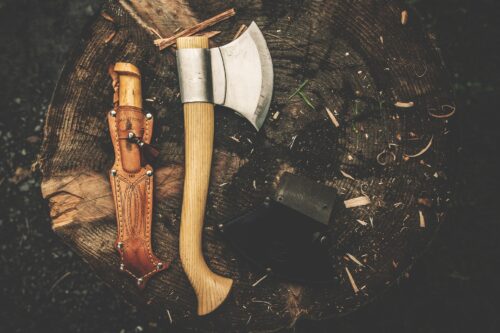
There are many different things that can be made using axe carving techniques, including decorative woodcarvings, furniture, sculptures, and more. Some of the most common items that are made using axe carving techniques include spoons, bowls, and other small decorative objects.
As for which axe to use, it really depends on the type of project you are working on, for smaller, more delicate projects, you may want to use a smaller axe with a finer blade, such as a carving hatchet. For larger projects, you may want to use a larger, more heavy-duty axe, such as a felling axe or a splitting axe.
Enjoy The Journey
Wood carving is a rewarding and satisfying hobby that can bring joy and creativity to your life. Whether you’re a beginner just starting out or an experienced woodworker looking to the future and wanting to try something new, there’s always more to learn and discover in the world of woodworking. With practice and dedication, you’ll be able to create beautiful pieces that you can really be proud of. Happy wood carving everyone!